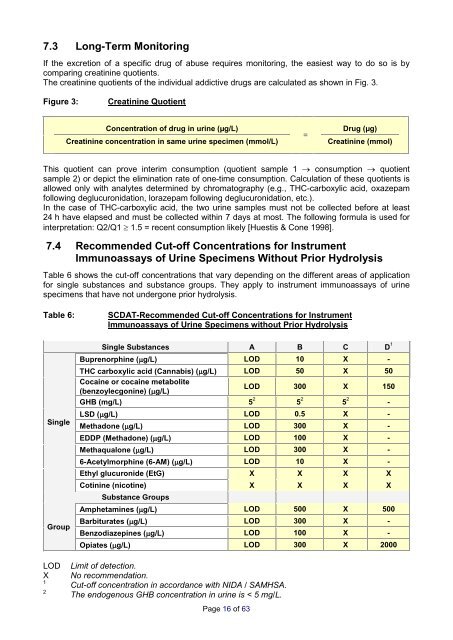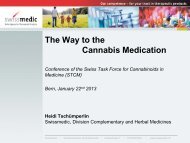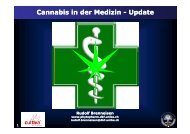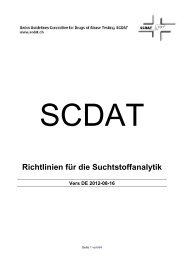Guidelines for Drugs of Abuse Testing vers 2012 - Brenneisen
Guidelines for Drugs of Abuse Testing vers 2012 - Brenneisen
Guidelines for Drugs of Abuse Testing vers 2012 - Brenneisen
Create successful ePaper yourself
Turn your PDF publications into a flip-book with our unique Google optimized e-Paper software.
7.3 Long-Term Monitoring<br />
If the excretion <strong>of</strong> a specific drug <strong>of</strong> abuse requires monitoring, the easiest way to do so is by<br />
comparing creatinine quotients.<br />
The creatinine quotients <strong>of</strong> the individual addictive drugs are calculated as shown in Fig. 3.<br />
Figure 3: Creatinine Quotient<br />
Concentration <strong>of</strong> drug in urine (µg/L)<br />
Creatinine concentration in same urine specimen (mmol/L)<br />
Page 16 <strong>of</strong> 63<br />
=<br />
Drug (µg)<br />
Creatinine (mmol)<br />
This quotient can prove interim consumption (quotient sample 1 → consumption → quotient<br />
sample 2) or depict the elimination rate <strong>of</strong> one-time consumption. Calculation <strong>of</strong> these quotients is<br />
allowed only with analytes determined by chromatography (e.g., THC-carboxylic acid, oxazepam<br />
following deglucuronidation, lorazepam following deglucuronidation, etc.).<br />
In the case <strong>of</strong> THC-carboxylic acid, the two urine samples must not be collected be<strong>for</strong>e at least<br />
24 h have elapsed and must be collected within 7 days at most. The following <strong>for</strong>mula is used <strong>for</strong><br />
interpretation: Q2/Q1 ≥ 1.5 = recent consumption likely [Huestis & Cone 1998].<br />
7.4 Recommended Cut-<strong>of</strong>f Concentrations <strong>for</strong> Instrument<br />
Immunoassays <strong>of</strong> Urine Specimens Without Prior Hydrolysis<br />
Table 6 shows the cut-<strong>of</strong>f concentrations that vary depending on the different areas <strong>of</strong> application<br />
<strong>for</strong> single substances and substance groups. They apply to instrument immunoassays <strong>of</strong> urine<br />
specimens that have not undergone prior hydrolysis.<br />
Table 6: SCDAT-Recommended Cut-<strong>of</strong>f Concentrations <strong>for</strong> Instrument<br />
Immunoassays <strong>of</strong> Urine Specimens without Prior Hydrolysis<br />
Single<br />
Group<br />
Single Substances A B C D 1<br />
Buprenorphine (µg/L) LOD 10 X -<br />
THC carboxylic acid (Cannabis) (µg/L) LOD 50 X 50<br />
Cocaine or cocaine metabolite<br />
(benzoylecgonine) (µg/L)<br />
LOD 300 X 150<br />
GHB (mg/L) 5 2 5 2 5 2 -<br />
LSD (µg/L) LOD 0.5 X -<br />
Methadone (µg/L) LOD 300 X -<br />
EDDP (Methadone) (µg/L) LOD 100 X -<br />
Methaqualone (µg/L) LOD 300 X -<br />
6-Acetylmorphine (6-AM) (µg/L) LOD 10 X -<br />
Ethyl glucuronide (EtG) X X X X<br />
Cotinine (nicotine)<br />
Substance Groups<br />
X X X X<br />
Amphetamines (µg/L) LOD 500 X 500<br />
Barbiturates (µg/L) LOD 300 X -<br />
Benzodiazepines (µg/L) LOD 100 X -<br />
Opiates (µg/L) LOD 300 X 2000<br />
LOD Limit <strong>of</strong> detection.<br />
X No recommendation.<br />
1<br />
Cut-<strong>of</strong>f concentration in accordance with NIDA / SAMHSA.<br />
2<br />
The endogenous GHB concentration in urine is < 5 mg/L.






